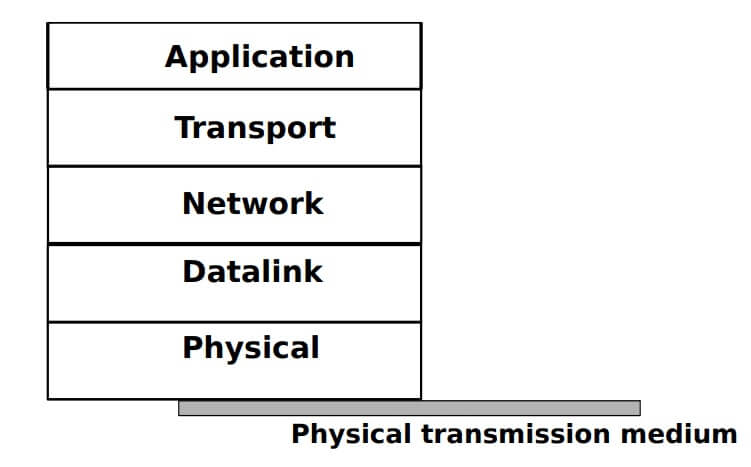Our reference model is divided into five layers, as shown in the figure below.
Starting from the bottom, the first layer is the Physical layer. Two communicating devices are linked through a physical medium. This physical medium is used to transfer an electrical or optical signal between two directly connected devices. Several types of physical mediums are used in practice :
electrical cable – Information can be transmitted over different types of electrical cables. The most common ones are the twisted pairs that are used in the telephone network, but also in enterprise networks and coaxial cables. Coaxial cables are still used in cable TV networks, but are no longer used in enterprise networks. Some networking technologies operate over the classical electrical cable.
optical fiber – Optical fibers are frequently used in public and enterprise networks when the distance between the communication devices is larger than one kilometer. There are two main types of optical fibers : multimode and monomode. Multimode is much cheaper than monomode fiber because a LED can be used to send a signal over a multimode fiber while a monomode fiber must be driven by a laser. Due to the different modes of propagation of light, monomode fibers are limited to distances of a few kilometers while multimode fibers can be used over distances greater than several tens of kilometers. In both cases, repeaters can be used to regenerate the optical signal at one endpoint of a fiber to send it over another fiber.
| Application |
| Transport |
| Network |
| Datalink |
| Physical |
The five layers of the reference model
wireless – In this case, a radio signal is used to encode the information exchanged between the communicating devices. Many types of modulation techniques are used to send information over a wireless channel and there is lot of innovation in this field with new techniques appearing every year. While most wireless networks rely on radio signals, some use a laser that sends light pulses to a remote detector. These optical techniques allow to create point-to-point links while radio-based techniques, depending on the directionality of the antennas, can be used to build networks containing devices spread over a small geographical area.
An important point to note about the Physical layer is the service that it provides. This service is usually an unreliable connection-oriented service that allows the users of the Physical layer to exchange bits.
The unit of information transfer in the Physical layer is the bit. The Physical layer service is unreliable because :
- The Physical layer may change, e.g. due to electromagnetic interferences, the value of a bit being transmitted
- The Physical layer may deliver more bits to the receiver than the bits sent by the sender
- The Physical layer may deliver fewer bits to the receiver than the bits sent by the sender
The last two points may seem strange at first glance. When two devices are attached through a cable, how is it possible for bits to be created or lost on such a cable?
This is mainly due to the fact that the communicating devices use their own clock to transmit bits at a given bit rate. Consider a sender having a clock that ticks one million times per second and sends one bit every tick.
Every microsecond, the sender sends an electrical or optical signal that encodes one bit. The sender’s bit rate is thus 1 Mbps. If the receiver clock ticks exactly every microsecond, it will also deliver 1 Mbps to its user.
However, if the receiver’s clock is slightly faster (resp. slower), than it will deliver slightly more (resp. less) than one million bits every second. This explains why the physical layer may lose or create bits.
Note : Bit rate
In computer networks, the bit rate of the physical layer is always expressed in bits per second. One Mbps is one million bits per second and one Gbps is one billion bits per second. This is in contrast with memory specifications that are usually expressed in bytes (8 bits), KiloBytes ( 1024 bytes) or MegaBytes (1048576 bytes). Thus transferring one MByte through a 1 Mbps link lasts 8.39 seconds.
| Bit rate | Bit per second |
| 1 Kbps | 102 |
| 1 Mbps | 106 |
| 1 Gbps | 109 |
| 1 Tbps | 1012 |
The physical layer allows thus two or more entities that are directly attached to the same transmission medium to exchange bits. Being able to exchange bits is important as virtually any information can be encoded as a sequence of bits. Electrical engineers are used to processing streams of bits, but computer scientists usually prefer to deal with higher level concepts.
A similar issue arises with file storage. Storage devices such as hard-disks also store streams of bits. There are hardware devices that process the bit stream produced by a hard-disk, but computer scientists have designed filesystems to allow applications to easily access such storage devices.
These filesystems are typically divided into several layers as well. Hard-disks store sectors of 512 bytes or more. Unix filesystems group sectors in larger blocks that can contain data or inodes representing the structure of the filesystem. Finally, applications manipulate files and directories that are translated in blocks, sectors and eventually bits by the operating system.
Computer networks use a similar approach. Each layer provides a service that is built above the underlying layer and is closer to the needs of the applications.
The Datalink layer builds on the service provided by the underlying physical layer. The Datalink layer allows two hosts that are directly connected through the physical layer to exchange information.
The unit of information exchanged between two entities in the Datalink layer is a frame. A frame is a finite sequence of bits.
Some Datalink layers use variable-length frames while others only use fixed-length frames. Some Datalink layers provide a connection-oriented service while others provide a connectionless service. Some Datalink layers provide reliable delivery while others do not guarantee the correct delivery of the information.
An important point to note about the Datalink layer is that although the figure below indicates that two entities of the Datalink layer exchange frames directly, in reality this is slightly different.
When the Datalink layer entity on the left needs to transmit a frame, it issues as many Data.request primitives to the underlying physical layer as there are bits in the frame. The physical layer will then convert the sequence of bits in an electromagnetic or optical signal that will be sent over the physical medium.
The physical layer on the right hand side of the figure will decode the received signal, recover the bits and issue the corresponding Data.indication primitives to its Datalink layer entity. If there are no transmission errors, this entity will receive the frame sent earlier.
The Datalink layer allows directly connected hosts to exchange information, but it is often necessary to exchange information between hosts that are not attached to the same physical medium. This is the task of the network layer. The network layer is built above the datalink layer. Network layer entities exchange packets. A packet is a finite sequence of bytes that is transported by the datalink layer inside one or more frames.
A packet usually contains information about its origin and its destination, and usually passes through several intermediate devices called routers on its way from its origin to its destination.

Most realisations of the network layer, including the internet, do not provide a reliable service. However, many applications need to exchange information reliably and so using the network layer service directly would be very difficult for them. Ensuring the reliable delivery of the data produced by applications is the task of the transport layer. Transport layer entities exchange segments.
A segment is a finite sequence of bytes that are transported inside one or more packets. A transport layer entity issues segments (or sometimes part of segments) as Data.request to the underlying network layer entity.
There are different types of transport layers. The most widely used transport layers on the Internet are TCP, that provides a reliable connection-oriented byte stream transport service, and UDP, that provides an unreliable connection-less transport service.
The upper layer of our architecture is the Application layer. This layer includes all the mechanisms and data structures that are necessar y for the applications. We will use Application Data Unit (ADU) to indicate the data exchanged between two entities of the Application layer.
| Read More Topics |
| Computer workcell control |
| Goals of AI research |
| Computer control of power system |






